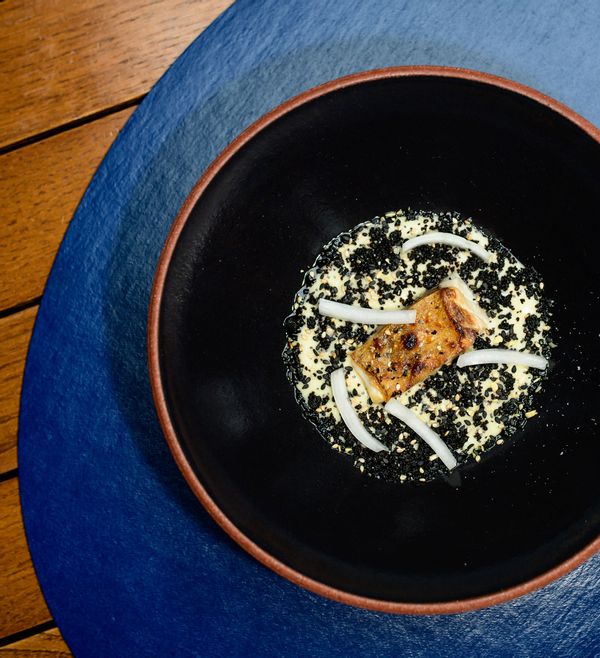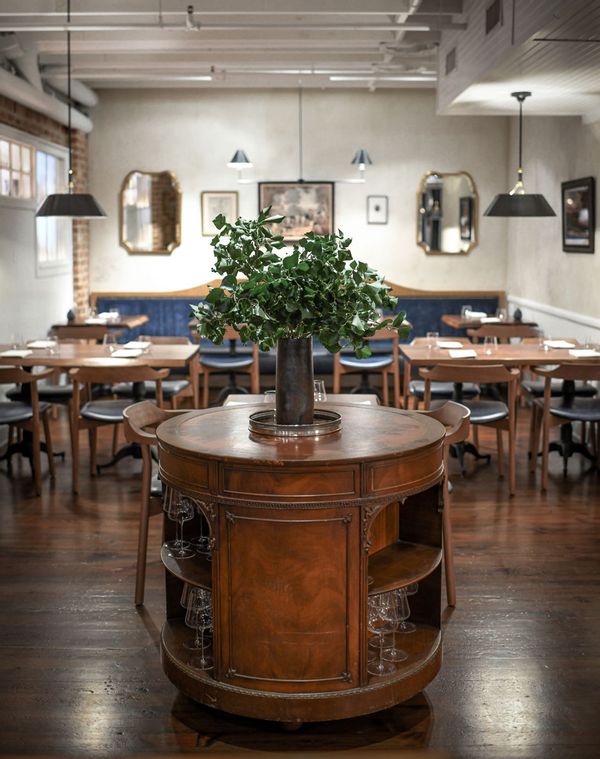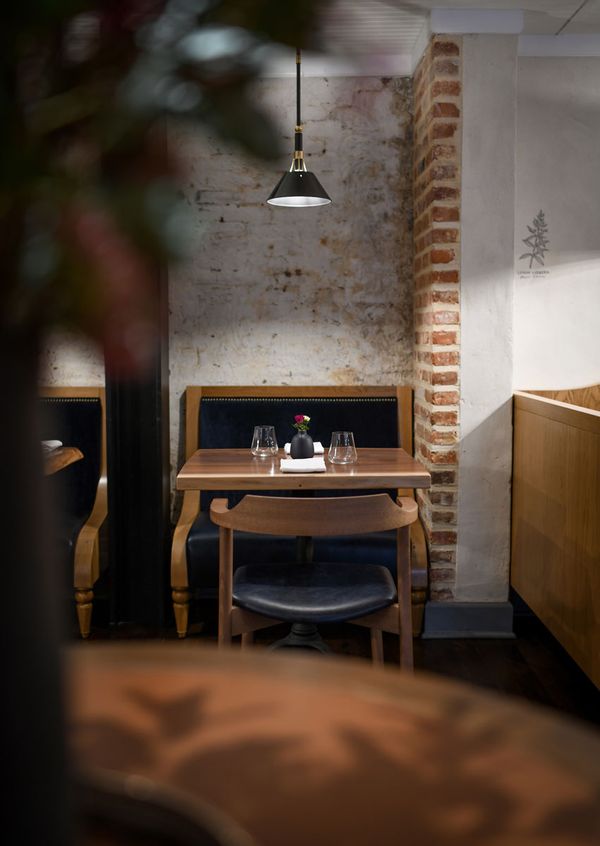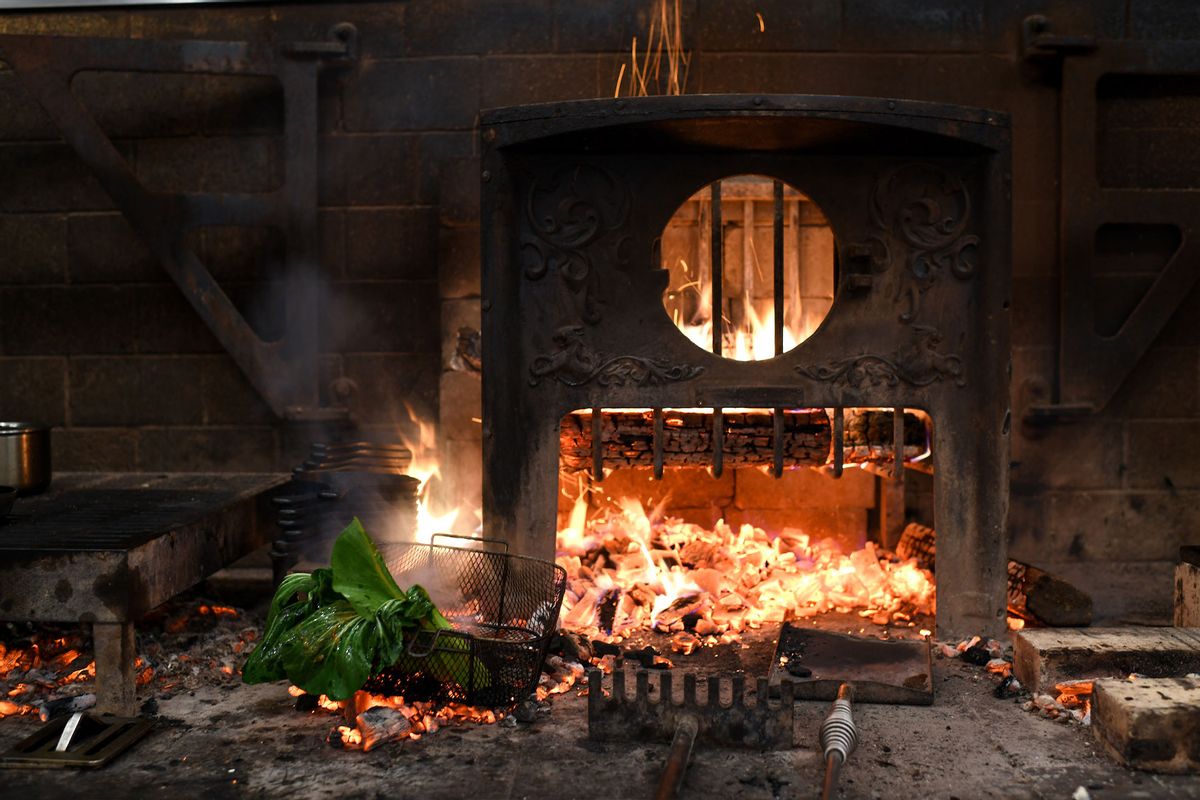In March 2017, I visited my brother in Washington, D.C. and we visited The Dabney, a then-two-year-old restaurant that had been garnering lots of high praise.
We were dropped off by an Uber or Lyft in the oddest, most unassuming area — essentially within an alley of some sorts, and only a few steps away was a large, wooden door next to a sign that read the name of the restaurant. I was intrigued by this and after walking inside and being immediately greeted with the smell of the large hearth as we were led to our table, I knew the experience would be a very pleasurable one.
After that trip, I wrote on a post on my Instagram that “. . . if you happen to come in contact with me within the next few weeks, prepare to hear me wax poetic about this restaurant for an inordinate amount of time. One of the best dining experiences I’ve ever had, @jjlthedabney . . . masterful.”
Now, seven years later, I had the opportunity to talk to the owner of that Instagram handle, Chef Jeremiah Langhorne, now uber-decorated with a countless amount of accolades, from Michelin to James Beards to the Washingtonian (which named it the #1 restaurant in DC in 2023) and more. Since that visit in 2017, Langhorne has opened Petite Cerise and The Dabney Cellar, and has continued to operate The Dabney, which retains its star from the Michelin Guide.
Langhorne and I spoke about dry-aged fish, his rooftop herb garden, the long-time dishes that remain on the Dabney menu, his next steps and much more.
Chef Jeremiah Langhorne (Bonjwing Lee)
The following interview has been lightly edited for clarity and length.
Hi! I know you’ve had some real stalwart dishes on the menu for quite some time — I seem to recall that the catfish slider was a real standby favorite?
Yes, the Sweet Potato Roll with Fried Chesapeake Catfish, Preserved Ramp tarter is a longtime favorite and is still available. It’s by request in the dining room. The main reason it was created was to give us a way to permanently keep Chesapeake Blue Catfish on our menu. They are incredibly invasive and we should be pulling as many out of the bay as we can. The good news is, they are also incredibly delicious with a clean sweet flavor and wonderful texture if prepared correctly.
Could you talk a bit about the dry aged fish offerings, please? I’m so fascinated by that idea. How did the idea come up? How exactly does it work?
I cooked in Charleston, SC for seven years and experienced incredible fishermen and quality. When I moved to DC, I wanted that same high-quality fish. Unfortunately, many restaurants here were sourcing fish from huge purveyors through a massive commercial process that compromised quality.
I began looking for small fishermen to work with to get direct access to the docks and the boats the fish were coming in on. Luckily a former employee and friend Phil Valiant became that guy. Over the past six years, we’ve been working on building a network of watermen that will give the specific care and procedures to the fish that we’re looking for.
Dry-aging fish is not a new technique, but the Western world has been slower to adopt it because we’re typically more profit and convenience-oriented than quality-oriented. I’m a huge food nerd and enjoy studying what other chefs and cultures are working on globally. The first place I looked was at Japanese cuisine. They are masters of fish. The information was helpful, but I didn’t make progress until I came across a chef named Josh Nihland from Australia. He opened a restaurant called St Peter with the sole purpose of reimagining the way we look at fish. The quality of the fish he cooks is evident. He was using similar techniques that I could relate to. I wanted our fish at The Dabney to be that quality. We dug into the dry-aging process to concentrate flavor and improve texture.
When you dry-age fish, the fish is first caught and bled. This means the fish is killed, the blood is drained and the guts are removed immediately. The fish is then rinsed in seawater and stored until the boat returns to shore. Next, the fish is taken directly to us. We try to get them on the same day. Then we cut the scales off using an incredibly sharp knife, the pockets of skin the scales sit in can hold water and breed bacteria growth. Once the scales are removed, the skin is patted dry. The fish is then hung in refrigeration with plenty of airflow for 7-9 days depending on the species. If you’ve removed all the parts that typically make a fish go bad then the fish will come out with beautifully dry skin that puffs like crackling when cooked and will have a dense flavor texture that is unlike any fish you’ve had before.
We now treat all our fish like this at The Dabney. We are certainly not the first to do this and I believe that more chefs will continue to adopt dry-aging with time. It’s going to take a lot of time to become mainstream but if quality is your goal It’s just better in every way.
 Aged Speckled Sea Trout, pumpernickel, lovage, potato and buttermilk (Kimberly Kong)
Aged Speckled Sea Trout, pumpernickel, lovage, potato and buttermilk (Kimberly Kong)
What does “The Dabney” mean?
The Dabney is an old family name.
How do you differentiate between Dabney and Dabney Cellar?
At The Dabney we use a tasting menu to showcase the amazing products of the Mid-Atlantic region through wood fire cooking and culinary technique. The Dabney Cellar is meant to be a simple bar that focuses on celebrating the products of this region that stand alone and don’t need any technique. For example, the beautiful local cheese, or country hams, as well as oysters and other amazing products. The vibe is very casual and was built to be a place we would want to spend an evening hanging out with friends over a bottle of wine.
What are the staples of Dabney? Its ethos, recurring dishes, etc.
Despite the menu changing daily, the ethos of The Dabney is consistent.
The Dabney continues to pay tribute to the wonderful farmers, watermen and purveyors of the mid-Atlantic region who provide some of the best and most unique products in the country. We celebrate these ingredients by preparing them in a large wood burning hearth not only for its uniqueness and depth of flavor, but to give a nod to the area’s historic food culture while growing and creating something new.
I just saw on your website that you hosted immersive grilling classes on July 4 — how fun! What gave you that idea?
I wanted to connect with our guests more. I love cooking over a wood fire and I feel like there are a lot of backyard BBQs going wrong. Hopefully, we can help teach our guests about cooking over embers and have a great time while we do it. Teaching is a passion of mine and we plan to continue the classes.
Tell me about Petite Cerise? The menu is beautiful and seems a bit lighter or more casual than The Dabney
That’s exactly right, Petite Cerise fulfills a couple of goals and dreams of mine.
First, I’m a big fan of France, the food, the people and the culture. I love it. My wife and I travel there pretty often. Their passion for food and life is incredible. I wanted to create a restaurant that could showcase true French cooking and a commitment to seasonality, quality and classic techniques.
At the same time, we knew we were evolving at The Dabney. As the format and price of the menu increased there to allow us to give our guests the best possible experience, I still wanted to have a very reasonable place where we could wow our guests with great food and value. We just launched our new $58 four-course prix fixe menu at Petite Cerise focused on the south of France. I want to over-deliver for our guests and bring back that connection and feeling of getting a great experience.
 Interior of The Dabney (Bonjwing Lee)
Interior of The Dabney (Bonjwing Lee)
I remember really loving the visual/aesthetic design of the menu and I’m glad it still has such an interesting look with the center “main” focus and the other offerings extending out around it.
The aesthetic is very important to us. The newest menu is based on old menus from the 18th and 19th century from grand dinner parties.
How much of the produce from the rooftop garden is used in the dishes?
The rooftop is used exclusively for herbs. We grow anywhere from 25 to 65 different varieties depending on the season and always find a way to use it all.
In another interview, I read that you said “it takes a long time to get good at cooking.”I love the simplicity of that comment. Could you speak to that a bit?
Of course, we currently live in a world that’s very much based on instant gratification, everyone wants everything now. Cooking is a craft and is not something you can just be amazing at in a year or two. Cooking is bottomless, there’s no way to learn it all. Allowing yourself to take the time to truly learn from and refine your technique over the years is very important. It’s crucial to know you won’t get there overnight. It’s a lifelong process of learning and evolution.
Want more great food writing and recipes? Subscribe to Salon Food’s newsletter, The Bite.
The website says “we know the names and faces of the people who grow our produce and provide our proteins.” What’s it like to cultivate those relationships throughout the mid-Atlantic region?
It’s wonderful, challenging, joyful and everything you could imagine. We’ve built amazing relationships with our farmers, fishermen and other purveyors. For example, I’ve worked with Casey and Stacey from Fireside Farm for almost 10 years, and the same with Clay Trainum from Autumn Olive Farms. We’re always looking for new folks to work with. The pandemic unfortunately caused many of them to move on to other endeavors or places so it’s a constant process, but we wouldn’t have it any other way.
 Interior of The Dabney (Bonjwing Lee)
Interior of The Dabney (Bonjwing Lee)
I know the hearth is a massive component of the Dabney, and as far as I can tell, practically every single dish you put out. Can you talk to me a bit about it?
The reason we built the hearth was simple: I wanted The Dabney to be the embodiment of the Mid-Atlantic region. A place born from the region’s culinary history but also a leader in its future. As I studied the culinary history of the Mid-Atlantic, I realized that just about every book had recipes for cooking in a hearth so if we wanted to truly understand the cuisine here we had to have a hearth.
Final note — not a question — but I love the location of the restaurant, the entrance. It’s been years, but all of that still sticks with me, as does the tremendous food and service, of course. I remember having sugartoads and loving that phrase!
Sugartoads is a great name. They call them that because they are ugly as toads, but sweet as sugar!!!!
